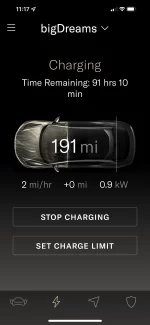The problem is that fast DC charging such as you get at an EA station is more taxing on the battery than the slower charging you'd get on a home 240-volt setup. You'll prolong battery life by home charging except for long road trips. Home charging also means you leave home every morning with the battery topped up to whatever limit you choose (typically 80% for best battery life), so you have plenty of range should an emergency arise.
Also, I'm confused by all this talk about third party chargers. If you don't need the V2H charging that the Lucid Wall Connector provides, all you need for home charging is a NEMA 14-50 240-volt outlet (a typical dryer outlet) of at least 50 amp capacity. The car comes with its own charger that you simply plug into the NEMA outlet.
it's just so easy to plug and unplug in the garage each day than worry about getting to a public charger when it might not be convenient, or that might or may not be working, or that might have a line waiting, or when the weather might be nasty just when you need to charge (as most public chargers are exposed to the elements).

